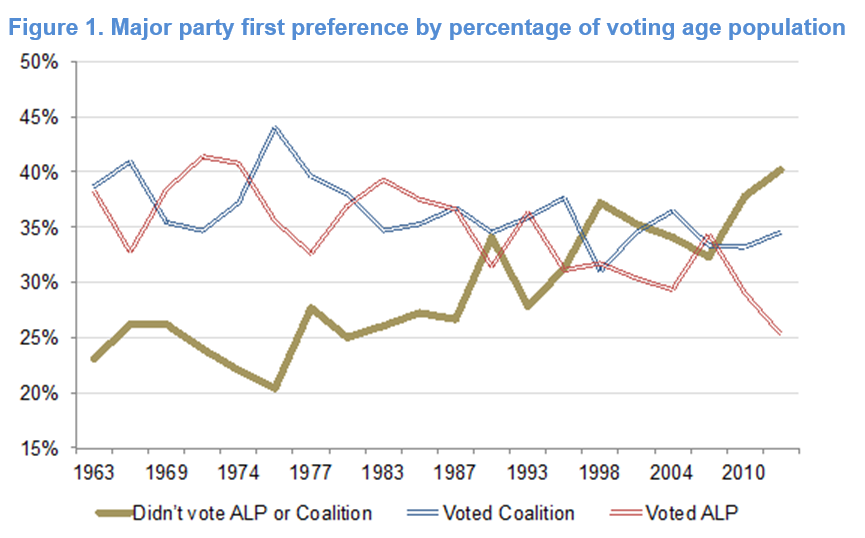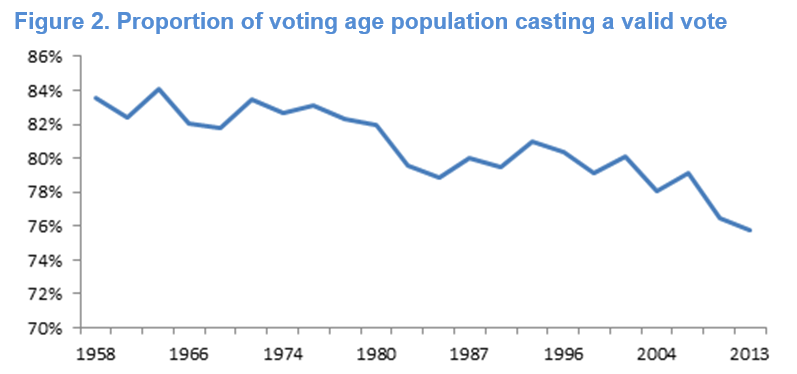The State of Australian Democracy
New research shows a rising number of the Australian adult population are not enrolled, not casting a vote or voting informally.
Combined with the sinking major party vote, nearly 40% of Australian adults did not vote for either party able to form government in 2013. The trend has been on the rise over the past decades, but sharply increased in the past two elections.
A new report by independent think-tank, The Australia Institute, investigates voting trends, showing a significant decline in major party voting over many decades.
Figure 1. Major party first preference by percentage of voting age population

The report includes new polling on the role of the Senate. 52% of respondents said they considered it normal for the government to have to seek support of crossbench Senators to pass legislation, and to risk having it being voted down.
“Many commentators and major party politicians have lamented what they depict as the ‘chaos’ of increasingly powerful cross benches in parliament,” Chief Economist of The Australia Institute, Richard Denniss said.
“The rising influence of independents is a symptom rather than the cause of the disconnection between voters and the major parties, with the majority of the public seeing the Senate crossbench not as an aberration, but the norm.
“The effect of this trend will be even more pronounced in the Senate in a double-dissolution scenario, but the trend away from the major parties is also putting more lower house seats in play.
In both the 2010 and 2013 elections, more Australians didn’t vote for a major party than voted for either the Coalition or Labor.
The decline in major party vote is often noted, but the report identified three other significant trends:
- a lower portion enrolling to vote,
- reduced turn out at elections and
- increasing rates of voters who do turn up failing to cast a valid vote
“If all of the people who didn’t vote Coalition or Labor formed a party, that party would have won the primary vote at the last two elections.”
“These figures raise a counterpoint to government claims of a ‘mandate’. Neither Labor nor the Coalition come close to winning the votes of a majority of Australians anymore.
“Almost two-thirds of voting age Australians didn’t vote for the current Coalition government.
“Negotiating with minor parties is the new normal in Australian politics and engaging with non-voters will be crucial for any party seeking to expand its influence,” Denniss said.
The figures reveal that despite a ‘compulsory voting’ policy, in 2013, only 75 per cent of adult Australians cast a valid vote in the federal election:
Figure 2. Proportion of voting age population casting a valid vote

NOTE: These figures are based on IDEA data for adult resident population, including those who are ineligible to enrol. Most of these permanent residents, while having all other responsibilities, including paying taxes, are not eligible to vote under current laws, no matter how long they have been in Australia (unless born in the UK and enrolled before 1984). AEC figure here, exclude these residents from unenrolled total. Given the principle of ‘no taxation without representation’ and the political focus on the expenditure of ‘taxpayers money’, voting data has been expressed as a proportion of residents to highlight the declining ‘mandate’ associated with electoral victory.
